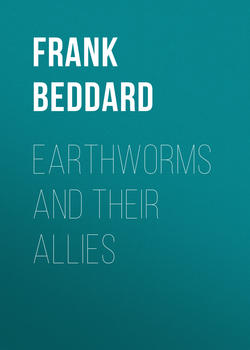Earthworms and Their Allies

Реклама. ООО «ЛитРес», ИНН: 7719571260.
Оглавление
Beddard Frank Evers. Earthworms and Their Allies
PREFACE
CHAPTER I. STRUCTURAL AND SYSTEMATIC
The Anatomy of Earthworms
The Aquatic Families of Oligochaeta
CHAPTER II. MODE OF LIFE
Aquatic Earthworms
Marine Species
Earthworms originally purely aquaticanimals
CHAPTER III. THE EXTERNAL FEATURES OF EARTHWORMS ANDTHEIR RELATION TO HABIT AND ENVIRONMENT
CHAPTER IV. SENSE ORGANS AND SENSES OF EARTHWORMS
CHAPTER V. RELATIVE FREQUENCY OF EARTHWORMS INDIFFERENT REGIONS OF THE WORLD
The Range of Genera
CHAPTER VI. PEREGRINE FORMS
CHAPTER VII. THE EARTHWORMS OF OCEANIC ISLANDS
CHAPTER VIII. MOVEMENT AND MIGRATION AMONG EARTHWORMS
Climate as Affecting Migration
Mountain Ranges and the Migrationof Earthworms
The Ocean As a Barrier To Migration
Facilities of Migration
CHAPTER IX. THE GEOGRAPHICAL DISTRIBUTION OFEARTHWORMS
Отрывок из книги
The group of segmented, bristle-bearing, worms, termed Oligochaeta by zoologists, comprises what are popularly known as earthworms together with certain forms, inhabitants of ponds, lakes and rivers, which are not so well known as to have received a more distinctive name than merely 'worms.' Their next allies are apparently the leeches and – a little more remote – marine bristle-bearing worms termed Polychaeta; the three groups, together with perhaps a certain number of other forms belonging to smaller groups, constitute the Annelida which are a distinct and separate assemblage of invertebrate animals.
The most interesting features about these Oligochaetous worms are their very great anatomical variation and the facts of their distribution over the globe. Their importance as geological agents in levelling the ground was made known a long time ago by Darwin, and that aspect of earthworms has remained in much the same position as Darwin left it. We shall concern ourselves here only with the structure, habits, and range of the earthworms and their immediate allies, the aquatic Oligochaeta. These three aspects of the animals dovetail into each other more thoroughly than is the case with some other groups. This is due to the fact that they have of late years been very thoroughly studied from the anatomical and distributional side. So lately as 1889, M. Vaillant in a very comprehensive treatise was only able to enumerate 369 species, of which a large number were but incompletely differentiated, and some are no longer admitted. There are at the moment of writing perhaps 1500 species, the vast majority of which are well known owing to careful investigation. Furthermore there are but few parts of the world, and these are not of large area, from which earthworms at any rate have not been gathered. Though there can be no doubt that a very considerable number of species await discovery, it would seem that we are in possession of information which is not likely to be seriously affected by future researches.
.....
It will appear therefore that many and considerable differences divide Pontoscolex from Notiodrilus and indeed from all of the Megascolecidae whose structure has been touched upon in the foregoing pages. The most important of these are the ornamented setae and their arrangement and the modification of the setae upon the clitellum: the absence of diverticula to the spermathecae: the absence of terminal glands associated with the male ducts. Although taken in their entirety these characters are distinctive of the American Geoscolecidae (sub-family Geoscolecinae), there is no one of them which is not to be found in some Megascolecid. Thus the subgenus Ilyogenia (of Ocnerodrilus) has sometimes no spermiducal glands: the genus Perionyx has spermathecae without diverticula in some species, and other genera of Megascolecinae are in a like condition. The setae of Dichogaster are sometimes ornamented, while in Pheretima houlleti the clitellar setae are different from those upon the other segments.
We can in fact only define the family Geoscolecidae by an assemblage of characters which are mainly these: dorsal pores absent, only a few in the neck region being occasionally present; setae generally ornamented, those of the clitellum being larger and more marked than the others; spermathecae without diverticula; often instead of a pair of those pouches in the segment a large number of very small sacs, as in Microchaeta, Kynotus. Sperm ducts without terminal glandular or muscular sac, except in a few cases; setae always eight in a segment except in the genus Periscolex which has acquired the 'perichaetous' condition. The range of variation shown in the anatomy of the Geoscolecidae will be best taken in connection with the several sub-families into which it has been subdivided. In the first of these, the Geoscolecinae, no great differences divide the genera from that selected as the type, viz. Pontoscolex. The long sperm sacs attain to an extraordinary length in Trichochaeta (or Hesperoscolex) where the single pair extends through no less than 109 segments. Though as a general rule the sperm ducts open directly on to the exterior they do so through the intermediary of a large pouch in Glossoscolex (= Titanus). In Onychochaeta the setae on the last segments of the body are very much enlarged and thus form a more effective means of holding on to the soil than is possessed by other species.
.....